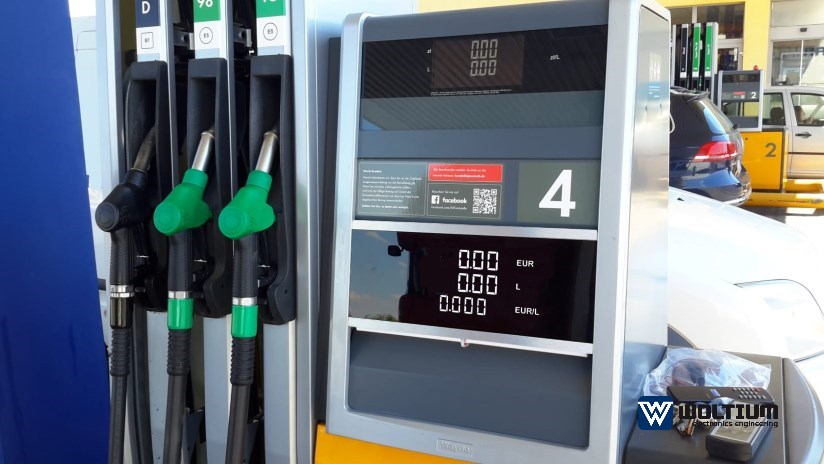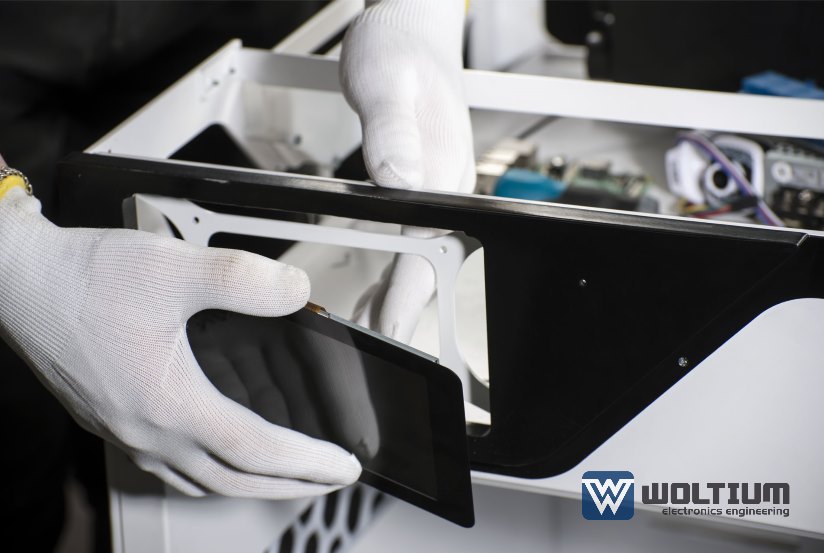LED displays

LED electronic information displays (panels) are one of the most effective informing and warning means at the moment. It is possible to display information about the free places on the parking, ambient temperature and road surface, date and time, discounts in shop, relevant exchange rates and many other things by means of LED display.
It is possible to display any text, digital and graphic information (relevant with synchronization wireless or wire interface of communication at present) on these displays.
The set in multimedia functions allow to display information: with special effects, graphics, a possibility of information recurrence setup on time and day of the week or date.
Setup of panel operation modes and change of the text graphic information on the screen is carried out from any computer, which has the set software. The managing program for panel demands only from the user elementary skills of work on the computer at the level of initial level: Windows and Word.
Shopping centers, chemists, automobile parkings, production workshops, logistic centers, hotels, stations and the airports, public institutions are an incomplete list of spheres, where it is possible to apply our LED boards.
We offer LED displays also the 7 segments displays with any overall dimensions, colors, protection classes for the street and rooms.
Many operation modes and ways of display are implemented on our LED panels:
- information display in the news ticker mode with a possibility of different high-speed and temporary parameters setup,
- the electronic clock with display of hours, minutes, seconds,
- timer of the return and direct counting: counting of days, hours, minutes, seconds and time to the programmed event (opening of shop, festive date, etc.),
- calendar: display of calendar date (day of the week, month, year),
- thermometer: display of air, water, soil, asphalt temperature
- energy saving mode: brightness control depending on illumination and time of day, auto disconnect at night, etc.
The resource of LEDs operation depending on the mode of operation is from 4 to 15 years
Maximum height and width of figure depending on implementable technology are 60-100 cm.
Offer realization of 7 segment displays for our clients, which can be built to devices, machines, production lines — everywhere there where they will be applied, or implementation separate thin cases with necessary for you dimensions. We can produce these cases taking into account external factors, where they will be used, in particular these cases can be produced from fire-resistant plastic also they can have necessary degree of protection, for example IP64, IP65.
For convenience of mounting also we provide the most suitable mounting fastening for further safety and convenience of system operation.
We give important value to design execution of both segments, and cases in which these segments are built in. We constantly work on search of new esthetic solutions, so that displays not only performed their basic function also well fitted to esthetic integrity of the place, where they are set.
Touch displays
The touch displays which appeared in the seventies of the last century allow to integrate in one device input system and display system.
The touch screen (or panel) most often is installed over LCD panel. The touch screens which are the most extended today are resistive and multiple panels, each of them has advantages and features of application.
The resistive ("resisting") display reacts to contacts with a certain effort. Two flexible metal plates which are energized are responsible for determination of clicking in such display. They are located at small distance from each other directly under the screen. When you press on the display by finger or the stylus, the upper plate bends and touches the lower one. Coordinates are read out and transferred to processing. It occurs very quickly thanks to modern logical chips, action is activated for some seconds. Resistive displays are rather cheap. It is possible to work with them by means of any hard object.
Multiple display strongly differ from resistive one. Everyone can notice the difference. It is not necessary to put big effort for effective work with multiple sensors, it is enough to touch slightly a sensitive surface and clicking will be processed. The transparent layer of conduction elements located over the most LCD display is responsible for determination of exact coordinates there (it is energized too).
The human body bears electric charge and when you touch the screen by hand, the charge in a common ground changes. The controller registers, in what place the charge was changed, and transfers data to the operating system for processing. Multiple displays are much more convenient, but it is necessary to touch them with bare hands, they do not distinguish clicking by the stylus, they do not react to a finger in a glove in any way.
Touch multiple screens allow recognition of several points of contact (multi-fingers), any points of contact at once (multi-touch).
Our company is ready to develop for you the project with using touch (or at the request not touch) color screens with different technical parameters. Considering a scope (industrial automation, the measuring equipment, the medical equipment, information screens) we try to design with the point of view the best interaction of the operator-device system.
Displays can be divided into several types depending on the production technology, constructions, optical, electrical characteristics. The wide choice of different types, also control interfaces allows to select suitable version. We want to present you the most usable types.
LCD-TFT displays

Active matrixes designate by abbreviation TFT (Thin Film Transistor). It is technology of thin film transistors, which is applied in active, and matrix displays. About three transistors (each of which corresponds to one of three basic colors – red, green or blue) also the condenser supporting necessary voltage are the share of each pixel of the image. Such technology means spiral location of crystals, which in the conditions of strong potention do turn in such a way that the screen will be black. And in the absence of potention of big power we see the white screen. The basic principle of matrix operation consists in control of luminous flux intensity by means of its polarization. Change of polarization vector is carried out by liquid crystals depending on the electric field attached to them. It is possible to increase considerably high-speed performance of the display also to increase contrast and image clarity in comparison with normal, passive liquid crystal matrix, by means of the active matrix controlled by thin film transistors.
TN
One of the simplest matrix technologies. TN + film means the additional layer used for providing visibility by 90-170 degrees in horizontal direction and 65-160 – in vertical direction. The word film is often missed in the name, calling just TN displays. They are cheaper. Because the image is not ideal at such screens at viewing at angle and, also color rendition is inferior to displays with IPS or OLED.
TN matrix have the high response speed - the minimum time necessary for pixel for change of the brightness. Besides TN displays are economic in energy consumption and durable.
IPS is one of types of TFT matrix. The technology of matrix of the IPS LCD screen (In-Plane Switching) means parallel arrangement of crystals on all surface of monitor. Spirals are absent here. Therefore crystals in the conditions of strong potention do not turn. In other words the IPS technology is nothing else as the improved TFT. It displays black color much better, thereby improving degree of contrast and image brightness. For this reason this technology is more expensive, than classical TFT.
How black color is displayed, directly affects image contrast. If to incline the screen with TFT technology without IPS, so it will almost impossible to read something. And all because the screen at the inclination will be black. If to consider IPS matrix, so thanks to the fact that transfer of black color is realized by crystals, the image will be ideally accurate.
The matrix of TN-TFT loses in color image, because of that each pixel has own shade and it leads to color distortion. The screen with IPS technology transfers the image much more carefully.
One of advantages of TN-TFT screens over IPS is the high-speed response. Because IPS spends a lot of time for the turn of parallel crystals. So we can draw a conclusion that where the speed of plotting has great importance, it is better to use the screen with TN matrix. Displays with IPS technology are more slowly, but it is invisible in everyday life. And it is possible to reveal this distinction only having applied the technological tests which are specially intended for this purpose.
Displays with IPS technology, in difference from TN-TFT, demand more energy. It is caused by the fact, that to turn parallel crystals, big potention is necessary. As a result the battery has more loading, than at using TFT of matrix. If you need the device operated from internal power supply with small power consumption, so the classic TFT technology will be more suitable option.
OLED displays
OLED (Organic Light Emitting Diodes) — electroluminescent displays with organic light-emitting semiconductors. The main difference is that illumination lamps are not necessary. Surface elements shine in new displays. They shine significantly more brightly, than LCD screens (100000 cd/m2). At the same time, energy consumption is lower, the color rendition is better, the contrast is higher (300:1), the viewing angle is bigger (up to 178 degrees), the color coverage is broader. Unlike the normal LCD display the organic matter is capable to react 100-1000 times quicker. Thickness of the display does not exceed 1 mm (taking into account 2 mm cover plate), weight is calculated by grams. Important parameter is also operational temperature range: from-30 up to 60 degrees. From shortcomings it is possible to indicate only relatively low lifetime (about 5000-8000 hours). How organic screens are arranged? Once inventors of luminescent diodes found out that if to combine two layers of certain organic materials and to pass through them at one point electric current, so the luminescence will appear in this point/place. At the same time using different materials and light filters, it is possible to receive different colors. There is OLED with passive and with active matrixes. The principle of operation of matrixes the same, but it is used layer of organic semiconductors instead of liquid crystals layer.
If to compare modern OLED displays and old LCD screens, so the comparison will be not in favor of the last: LCD displays work already at limit of the opportunities, the speed of frames change on the screen is low, and power consumption leaves to wish smaller. It is difficult to see something at sunlight on color LCD screens, they are very brittle.
The technology of organic displays is deprived practically all shortcomings, that are characteristic of LCD displays, and it provides the better characteristics of the image.
OLED display.
Physically organic electroluminescent display is the integral device consisting of several very thin organic films between two conductors. Feeding on these conductors the small voltage (about 2-8 volts) also forces the display to radiate light. The basis of OLED matrix is produced from polymeric materials, their continuous improvement in no small measure promotes improvement of displays and development of manufacturing techniques of matrix.




